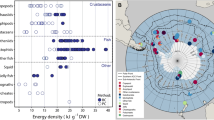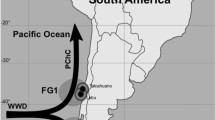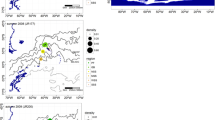Abstract
For a better understanding of the role of mesopelagic fish in the Southern Ocean food web, the energy and water content of Bathylagus antarcticus, Electrona antarctica and Gymnoscopelus braueri from the Lazarev Sea were investigated. Mean dry weight energy content of B. antarcticus (20.4 kJ g−1) was significantly lower than in E. antarctica and G. braueri (both 29.4 kJ g−1). In E. antarctica, an increase of dry weight energy density with age was evident from 26.9 kJ g−1 in juveniles of less than 1 year of age to 32.0 kJ g−1 in 3-year-old fish. Water content decreased with size in all three species. Abundant high-energy species such as E. antarctica are at a key position in the food web. Due to a marked influence of age on energy content, population structure can be an important variable in estimates of energy fluxes in the Southern Ocean ecosystem.




Similar content being viewed by others
References
Ainley DG, Fraser WR, Smith WOJ, Hopkins TL, Torres JJ (1991) The structure of upper level pelagic food webs in the Antarctic: effect of phytoplankton distribution. J Mar Syst 2:111–122
Ainley DG, Ribic CA, Fraser WR (1992) Does prey preference affect habitat choice in Antarctic seabirds? Mar Ecol Prog Ser 90:207–221
Ainley DG, Ribic CA, Fraser WR (1994) Ecological structure among migrant and resident seabirds of the Scotia–Weddell Confluence region. J Anim Ecol 63:247–364
Anthony JA, Roby DD, Turco KR (2000) Lipid content and energy density of forage fishes from the northern Gulf of Alaska. J Exp Mar Biol Ecol 248:53–78
Arnould JPY, Whitehead MD (1991) The diet of Antarctic petrels, cape petrels and southern fulmars rearing chicks in Prydz Bay. Ant Sci 3:19–27
Barrera-Oro E (2002) The role of fish in the Antarctic marine food web: differences between inshore and offshore waters in the southern Scotia Arc and west Antarctic Peninsula. Antarct Sci 14:293–309
Bost CA, Zorn T, LeMaho Y, Duhamel G (2002) Feeding of diving predators and diel vertical migration of prey: king penguins’ diet versus trawl sampling at Kerguelen Islands. Mar Ecol Prog Ser 227:51–61
Casaux R, Baroni A, Ramon A (2003) Diet of Antarctic fur seals Arctocephalus gazella at the Danco Coast, Antarctic Peninsula. Polar Biol 26:49–54
Casaux R, Bellizia L, Baroni A (2004) The diet of the Antarctic fur seal Arctocephalus gazella at Harmony Point, South Shetland Islands: evidence of opportunistic foraging on penguins? Polar Biol 27:59–65
Cherel Y, Ridoux V (1992) Prey species and nutritive value of food fed during summer to king penguin Aptenodytes patagonica chicks at Possession Island, Crozet Archipelago. Ibis 134:118–127
Clarke A, Prince PA (1980) Chemical composition and calorific value of food fed to Mollymauk chicks Diomedea melanophris and Diomedea Chrysostoma at Bird-Island, South Georgia. Ibis 122:488–494
Creet S, van Franeker JA, Van Spanje TM, Wolff WJ (1994) Diet of the Pintado Petrel Daption capense at King George Island, Antarctica, 1990/91. Mar Ornithol 22:221–229
Donnelly J, Torres JJ, Hopkins TL, Lancraft TM (1990) Proximate composition of Antarctic mesopelagic fishes. Mar Biol 106:13–23
Eder EB, Lewis MN (2005) Proximate composition and energetic value of demersal and pelagic prey species from the SW Atlantic Ocean. Mar Ecol Prog Ser 291:43–52
Geiger SP, Donnelly J, Torres JJ (2000) Effect of the receding ice-edge on the condition of mid-water fishes in the northwestern Weddell Sea: results from biochemical assays with notes on diet. Mar Biol 137:1091–1104
Gon O (1990) Bathylagidae. In: Gon O, Heemstra PC (eds) Fishes of the Southern Ocean. JLB Smith Institute of Ichthyology, Grahamstown, RSA, pp 107–110
Greely T, Gartner JVJ, Torres JJ (1999) Age and growth of Electrona antarctica (Pisces: Myctophidae), the dominant mesopelagic fish of the Southern Ocean. Mar Biol 133:145–158
Hartmann KJ, Brandt SB (1995) Estimating energy density of fish. Trans Am Fish Soc 124:347–355
Hopkins TL, Ainley DG, Torres JJ, Lancraft TM (1993) Trophic structure in open waters of the marginal ice zone in the Scotia–Weddell confluence region during spring (1983). Polar Biol 13:389–397
Hubold G (1985) The early life-history of the High-Antarctic silverfish, Pleuragramma antarcticum. In: Siegfried W, Condy P, Laws R (eds) Antarctic nutrient cycles and food webs. Springer, Berlin, Heidelberg, New York, pp 445–451
Hulley PA (1990) Myctophidae. In: Gon O, Heemstra P (eds) Fishes of the Southern Ocean. JLB Smith Institute of Ichthyology, Grahamstown, RSA, pp 146–178
Kock KH (1992) Antarctic fish and fisheries. Cambridge University Press, Cambridge, p 359
Lancraft TM, Torres JJ, Hopkins TL (1989) Micronekton and macrozooplankton in the open waters near Antarctic ice edge zones (AMERIEZ 1983 and 1986). Polar Biol 9:225–233
Lancraft TM, Hopkins TL, Torres JJ, Donnelly J (1991) Oceanic micronektonic/macrozooplanktonic community structure and feeding in ice covered Antarctic waters during the winter (AMERIEZ 1988). Polar Biol 11:157–167
Lawson JW, Magalhaes AM, Miller EH (1998) Important prey species of marine vertebrate predators in the northwest Atlantic: proximate composition and energy density. Mar Ecol Prog Ser 164:13–20
Lea M, Cherel Y, Guinet C, Nichols P (2002a) Antarctic fur seals foraging in the polar frontal zone: inter-annual shifts in diet as shown from fecal and fatty acid analysis. Mar Ecol Prog Ser 245:281–297
Lea MA, Nichols PD, Wilson G (2002b) Fatty acid composition of lipid-rich myctophids and mackerel icefish (Champsocephalus gunnari)—Southern Ocean food-web implications. Polar Biol 25:843–854
Osman LP, Hucke-Gaete R, Moreno CA, Torres D (2004) Feeding ecology of Antarctic fur seals at Cape Shirreff, South Shetlands, Antarctica. Polar Biol 27:92–98
Pakhomov EA, Perissinotto R, McQuaid C (1996) Prey composition and daily rations of myctophid fishes in the Southern Ocean. Mar Ecol Prog Ser 134:1–14
Paul AJ, Paul JM, Smith RL (1998) Seasonal changes in whole-body energy content and estimated consumption rates of age 0 walleye pollock from Prince William Sound, Alaska. Estuar Coast Shelf Sci 47:251–259
Pedersen J, Hislop JRG (2001) Seasonal variations in the energy density of fishes in the North Sea. J Fish Biol 59:380–389
Phleger CF, Nichols PD, Virtue P (1997) The lipid, fatty acid and fatty alcohol composition of the myctophid fish Electrona antarctica: high levels of wax esters and food chain implications. Ant Sci 9:258–265
Pusch C, Hulley PA, Kock KH (2004) Community structure and feeding ecology of mesopelagic fishes in the slope waters of King George Island (South Shetland Islands, Antarctica). Deep Sea Res I 51:1685–1708
Quillfeldt P (2002) Seasonal and annual variation in the diet of breeding and non-breeding Wilson’s storm-petrels on King George Island, South Shetland Islands. Polar Biol 25:216–221
Reinhardt SB, Van Vleet ES (1986) Lipid-composition of 22 species of Antarctic midwater zooplankton and fish. Mar Biol 91:149–159
Saadettin G, Dincer B, Alemdag N, Colak A, Turfekci M (1998) Proximate composition and selected mineral content of commercially important fish species from the Black Sea. J Sci Food Agric 78:337–342
Sabourenkov E (1990) Mesopelagic fish of the Southern Ocean—summary results of recent Soviet studies. WG-FSA-90/23, CCAMLR, Hobart, pp 433–457
Siegel V, Loeb V, Bergström B, Schöling S, Haraldsson M, Kitchener J, Vortkamp M (2004) Demography of Antarctic krill in the Lazarev Sea (Subarea 48.6) and the Elephant Island area (Subarea 48.1) in 2004. WG-EMM-04/23, CCAMLR, Hobart, pp 1–22
Tierney M, Hindell M, Goldsworthy S (2002) Energy content of mesopelagic fish from Macquarie Island. Ant Sci 14:225–230
Torres J, Somero G (1988) Vertical distribution and metabolism in Antarctic mesopelagic fishes. Comp Biochem Physiol 90B:521–528
Torres J, Donnelly J, Hopkins T, Lancraft T, Aarset A, Ainley D (1994) Proximate composition and overwintering strategies of Antarctic micronektonic crustacea. Mar Ecol Prog Ser 113:221–232
van Franeker JA (2001) Mirrors in ice. PhD Thesis, Rijksuniversiteit Groningen, Groningen, p 274
van Franeker JA, Bathmann UV, Mathot S (1997) Carbon fluxes to Antarctic top predators. Deep Sea Res II 44:435–455
Acknowledgements
Special thanks go to V. Siegel (Federal Research Centre for Fisheries, Hamburg) who kindly provided the sampling material for this study. We thank the crew of RV “Polarstern” and J. Buyse for their support. M. Leopold and J. Maes contributed to the improvement of this paper. This work was funded by the Belgian Science Policy (project PELAGANT EV/01/30B), the Dutch Ministry for Agriculture, Nature and Food quality (LNV) and the Dutch Polar Programme (NPP).
Author information
Authors and Affiliations
Corresponding author
Rights and permissions
About this article
Cite this article
Van de Putte, A., Flores, H., Volckaert, F. et al. Energy Content of Antarctic Mesopelagic Fishes: Implications for the Marine Food Web. Polar Biol 29, 1045–1051 (2006). https://doi.org/10.1007/s00300-006-0148-z
Received:
Revised:
Accepted:
Published:
Issue Date:
DOI: https://doi.org/10.1007/s00300-006-0148-z




